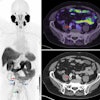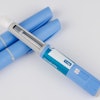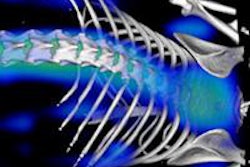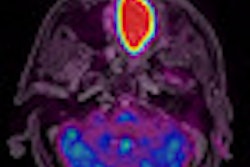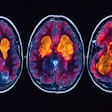
Radiology is moving more toward modality marriage, as specialists try to harvest optimum imaging yields at best cost-benefit ratios. PET/MRI, a pipe dream in years past, now looks to hold particular promise, with industry embarking on bold research and development programs, according to ECR 2011 President Dr. Yves Menu.
The emergence of PET/MRI has great potential in clinical routine due to its metabolic and morphological imaging capabilities, but because of the limitations of MRI, patients are routinely sent to CT, especially for cancer whole-body imaging. The hybrid PET/CT scanner has at times been considered problematic due to images gained at different times and on different machines, causing a lack of good "fusion," and PET/CT yields high radiation, noted Menu, chair and professor in the department of radiology, University of Pierre and Marie Curie, Paris.
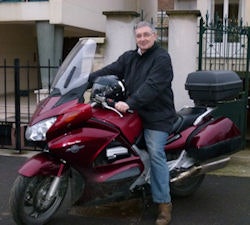 All revved up for PET/MRI: motorbiking enthusiast Dr. Yves Menu is convinced hybrid imaging represents the future.
All revved up for PET/MRI: motorbiking enthusiast Dr. Yves Menu is convinced hybrid imaging represents the future.
"When you do PET/CT, you are performing an excellent PET and a not-so-good CT. This is because the conditions for a good PET and a good CT are not the same. For chest CT, the patient needs to be still, breathe in deeply, and hold their breath. For PET, the patient needs to breathe gently," he told delegates at the 2012 Management in Radiology (MIR) meeting in Milan. "CT in PET/CT is used for attenuation mapping and for gross anatomical recognition. Few centers perform iodinated CT at the same time as PET and usually a second CT is required, which means more radiation."
A fully integrated PET/MR scanner costs around 6 million euros ($7.85 million U.S.), which is high compared to conventional PET/CT at around 1.5 million euros ($2 million U.S.), MR at 1.2 million euros ($1.6 million U.S.), and CT at an average of 700,000 euros ($916,000 U.S.). However, the integrated machine obviates the problems of PET/CT, chiefly through acquiring images at the same time on the same machine and without radiation exposure for patients, he explained.
Other PET/MR systems are now being developed at a lower overall cost to the buyer. So far, these seem to be based on different concepts: either two different gantries aligned, with the patient traveling between the two, or even two completely separate machines. Further technical progress is anticipated after this early phase of development, according to Menu.
3-tesla MRI was another hot topic during the MIR session on future trends, and he was keen to flag new research suggesting that there is no proven benefit of 3-tesla imaging over 1.5-tesla, except in clinical neuroimaging and scientific research.
"The advantage of 3-tesla in research is clear: spectroscopy, functional imaging, and tracking have improved. In clinical practice, 3-tesla might be better for prostate and some musculoskeletal indications, but the cost-benefit ratio is not necessarily in its favor," he commented. "Besides costs, there is a real increase in artifacts, and it is not proven as better for imaging other organs."
 Sales of 1.5-tesla MRI units are still increasing, while 3-tesla sales have reached a ceiling, noted Menu.
Sales of 1.5-tesla MRI units are still increasing, while 3-tesla sales have reached a ceiling, noted Menu.
His comments are supported by the recent paper, "A systematic review of the utility of 1.5- versus 3-tesla MR brain imaging in clinical practice and research," by Dr. Joanna Wardlaw et al, published online in June 2012 by European Radiology (Vol. 22, pp. 2295-2303).
"There is a lack of evidence of the superiority of 3-tesla because there is no valid comparison using up-to-date 1.5-tesla. If comparison was made between a new 1.5-tesla and a new 3-tesla, the advantages may not be so interesting," Menu said. "It is notable, moreover, that sales of 1.5-tesla are still increasing while 3-tesla sales have reached a ceiling, according to producers."
When it comes to buying a machine only for routine examinations, choosing a 3-tesla is, in all probability, disputable and unwise economically, Menu stated, alluding to reports that some governments across Europe were said to be reluctant to purchase 3-tesla MR scanners for hospitals.
The sentiment in hospital corridor talk that the overall number of imaging exams performed in European hospitals was diminishing -- particularly in southern Europe -- deserved closer scrutiny, he told AuntMinnieEurope.com. If such a reduction in examinations was taking place for economic reasons, it was vital to know whether hospitals were cutting down on needed exams, or if a proportion of the previous were "cosmetic" and only these superfluous exams were being axed. In addition, the pressure that some patients placed on physicians to prescribe imaging, especially in CT and MR, may have decreased owing to lower reimbursement and increased financial load on the patient.
"It would be interesting to see how the economic crisis was impacting imaging in Portugal, for example. Are there fewer exams? If so, are the remainder more -- or less -- useful? Is MR substituting for CT? We know that patients who used to be sent to CT now go to MR to the extent that musculoskeletal CT has almost disappeared. Maybe a survey would show, however, that overall no such substitution has taken place and other unexpected trends," Menu said.
He also warned about the worrying tendency of farming out reporting to call-center-styled stations where remote radiologists worked through "lists."
"This other brand of factory radiology is already a reality in some places today -- not just in China. U.K. hospitals send reports to India out-of-hours -- is this still clinical radiology?" Menu asked. "When you buy something, you eventually receive the bill! In the same way, we won't see errors immediately, but we will do in the end. The future of radiology in five years time will be a direct consequence of the decisions we take today."

